
貴石オパールと一般的なオパールの違いは何ですか?
 オパールといえば虹のような虹彩現象を思い浮かべる方が多いでしょう。他のオパールにはこの現象が見られないのを見て、戸惑う方もいるかもしれません。オパールには、プレシャスオパールとコモンオパールの2種類があることを知っておくことが重要です。プレシャスオパールの遊色効果こそが、プレシャスオパールとコモンオパールの大きな違いです。
オパールといえば虹のような虹彩現象を思い浮かべる方が多いでしょう。他のオパールにはこの現象が見られないのを見て、戸惑う方もいるかもしれません。オパールには、プレシャスオパールとコモンオパールの2種類があることを知っておくことが重要です。プレシャスオパールの遊色効果こそが、プレシャスオパールとコモンオパールの大きな違いです。
オパールは、形、サイズ、色が非常に多様なことから、「カメレオンの宝石」と呼ばれることもあります。人気のオパールには、クリスタルオパール、ブラックオパール、ウォーターオパールなどがあります。また、ティンテンバーと呼ばれる火山オパールのように、あまり知られていない種類も数多く存在します。
宝石愛好家なら、オパールは10月の誕生石、あるいは天秤座の星座石としてご存知かもしれません。オパールは「不運を招く」という迷信を耳にしたことがあるかもしれませんね。まさに迷信です。オパールはポジティブなエネルギーに満ちており、何世紀にもわたって存在してきました。
現代では、科学者や宝石学者がオパールの長年隠されていた秘密の多くを解明することができました。
重要な発見の一つは、貴重なオパールと一般的なオパールの違いです。
今日は、オパールの2つの主要な種類について知っておくべきことをすべて解説します。その過程で、一般的なオパールの見分け方や、どのオパールが最高級なのかなど、皆さんの切実な疑問にもお答えします。
まずは、一般的なオパールについて説明しましょう。
 デンドライトオパール(上の写真)は、火花や遊色現象を示さない一般的なオパールの一種です。
デンドライトオパール(上の写真)は、火花や遊色現象を示さない一般的なオパールの一種です。
一般的なオパールとは何ですか?
コモンオパール、またはポッチオパールは、2種類のオパールのうち、より多く産出されます。この種類のオパールを説明する最も簡単な方法は、それが何ではないかを説明することです。コモンオパールとは、遊色効果を示さないオパールのことです。では、遊色効果とは何でしょうか?
遊色現象は、プレシャスオパール特有の光学現象です。石の表面は、見る角度によって様々な色の輝きを放ちます。
一般的なオパールは遊色効果がないため、プレシャスオパールほどすぐには見分けられません。一般的なオパールの見分け方がわからない場合は、スクラッチテストが最も簡単な方法です。
コモンオパールは、ジャスパーなどの他の宝石とよく似ています。しかし、コモンオパールは他の宝石に比べて耐久性が著しく低く、モース硬度は5.5~6です。つまり、普通のポケットナイフで表面を傷つけることができるのです。
もう一つの識別方法は、重量です。例えば、ほぼ同じ大きさのオパールとクォーツの場合、オパールの方が明らかに軽いことがわかります。
一般的なオパールが割れたり、破損したりした場合、内部は石の他の部分と同じ光沢のある輝きを放ちます。瑪瑙のような類似の石は、破損すると内部がよりワックスのような光沢を放ちます。
一般的なオパールは遊色効果は見られませんが、それでも美しい色合いを呈します。パステルカラーのオパールには、淡いピンク、グリーン、イエロー、ブルーなどがあります。ホワイトオパールが最も多く産出され、ブラックオパールとレッドオパールは最も希少です。
自分の識別能力に自信がありますか?素晴らしい!
プレシャス オパールとコモン オパールの違いを探る旅の次の目的地は、虹色に輝くプレシャス オパールです。
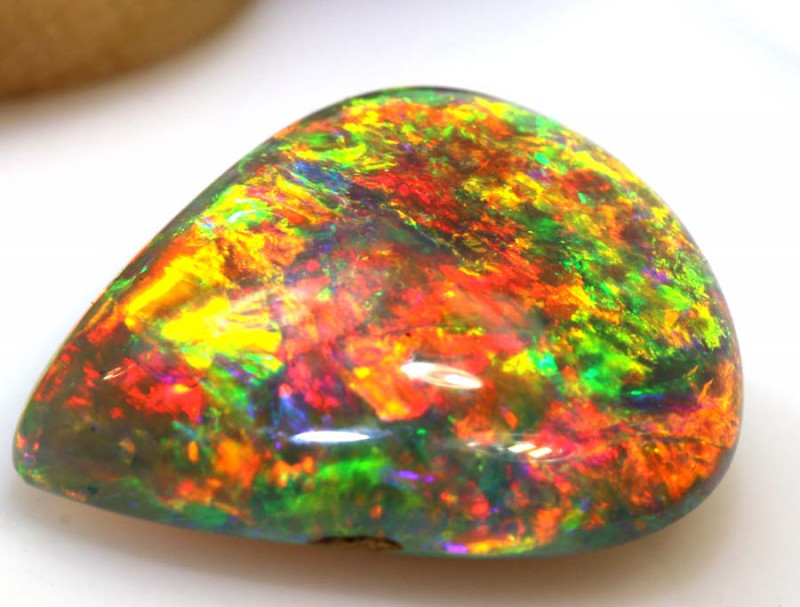 ライトニングリッジ産の印象的な貴重なオパール結晶 (上の写真) は、鮮やかな遊色効果を呈しています。
ライトニングリッジ産の印象的な貴重なオパール結晶 (上の写真) は、鮮やかな遊色効果を呈しています。
プレシャスオパールとは何ですか?
これまでお話ししてきたように、プレシャスオパールは遊色効果を見せるという点で際立っています。しかし、それはどのように機能するのでしょうか?遊色効果は何によって引き起こされるのでしょうか?
この宝石の遊色現象の理由は、18世紀以来、様々な科学者によって理論化されてきました。真の原因は、1966年にジョン・V・サンダースとピーター・J・ダラーという2人のオーストラリア人科学者によって解明されるまで解明されていませんでした。
サンダース氏とダラー氏の研究によると、遊色現象は貴重なオパールの内部構造によって発生します。
すべてのオパールはシリカと水で構成されています。顕微鏡レベルでは、シリカは球状です。一般的なオパールでは、球状は不規則で不均一です。一方、プレシャスオパールのシリカ球はすべて同じ大きさで、整然とした格子状に並んでいます。
オパールオークションのウェイン・セダウィー氏は、遊色現象は「シリカ球が宝石を通過する際に光を分解し、虹のあらゆる色に変える」ためだと述べています。ほとんどの貴重なオパールは虹のすべての色を見せるわけではありませんが、少なくとも3色は見せます。
しかし、この石の魅力は魅力的な虹彩だけではありません。不純物から生じるプレシャスオパールのボディトーンも同様に重要です。
オパールが形成される際、それが一般的なオパールであれ貴石オパールであれ、他の化学物質が混入することがあります。これらの元素がオパールのシリカ球の中に閉じ込められると、石に新たな地色、つまりボディトーンを与えます。
貴重なオパールには、白、黒、黄色、青など、いくつかの異なるボディトーンがあります。
オパールのボディトーンがわからない場合は、ぜひご参考ください!詳しくは「 オパールボディトーンガイド」をご覧ください。
さて、プレシャスオパールとコモンオパールの違いについてはご理解いただけたかと思います。しかし、プレシャスオパールとコモンオパールにはそれぞれ異なる種類があることをご存知でしたか?
一般的なオパールの種類
一般的なオパールには様々な色や種類があり、すべてをリストアップするのは大変です。その代わりに、知っておくべき主要な種類を絞り込みました。
アゲートオパール
アゲートオパールは、表面に縞模様の模様が見られるオパールの一種です。化石の周囲や岩脈に形成されることがあります。
アゲートオパールという名前ですが、アゲートは含まれていません。この名前は、この品種がアゲートの特徴的な色の縞模様に似ていることに由来しています。

モスオパール
モスオパールはオガララ層で産出され、様々な鉄鉱物の包有物を含んでいます。石の包有物は、苔の小さな枝分かれした巻きひげの集まりに似ています。
モスオパールは、そのインクルージョンがデンドライト(樹枝状結晶)とも呼ばれることから、「デンドリティックオパール」と呼ばれることもあります。モスオパールに含まれる最も一般的な鉄鉱物は酸化マンガンです。

ハイアライト
ハイアライトは、その透明度の高さが特別なオパールです。一般的なオパールは不透明な光沢を帯びることが多いですが、ハイアライトは半透明です。半透明のオパールは、ほとんどの場合、プレシャスオパールです。ハイアライトオパールを他の一般的なオパールと区別する特徴は、「グロビュール」と呼ばれる独特の球根状のクラスターです。
ハイアライトオパールは他の種類のオパールに比べて水分含有量が非常に少なく、約3~4%です。無色のこのオパールは、火山岩の空洞や二次鉱物を覆っている鉱床で形成されます。

ペルー産オパール
ペルー産オパールは、特定の石を指すのではなく、カテゴリーを指します。ペルーは美しいパステルカラーのオパールの産地として知られています。これらの柔らかな色合いの中で最も人気があるのは、ピンク、ブルー、グリーンです。
ペルー産オパールのほとんどは、イカ州またはカラヴェリ州のいずれかで産出されます。イカ州はピンクオパールが特産で、カラヴェリ州は「アンデスオパール」と呼ばれるブルーオパールを産出しています。
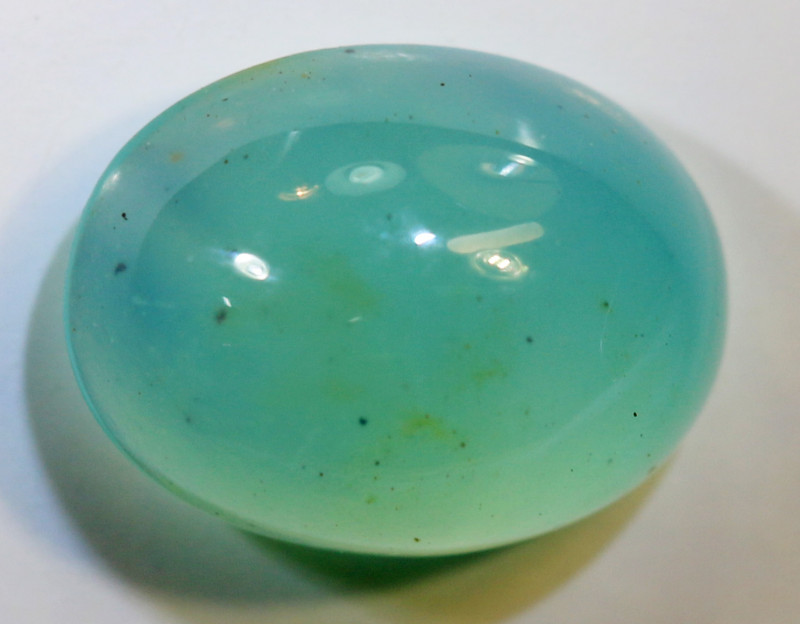
蛍光コモンオパール
蛍光オパールもまた魅力的なカテゴリーです。蛍光オパールは紫外線下で蛍光を発し、通常は鮮やかな緑色に輝きます。
これらのオパールの蛍光性はウランの存在によるものです。強い蛍光性を示す宝石のほとんどは、ネバダ州バージンバレー産です。
もちろん、プレシャスオパールにもそれぞれ異なる種類があります。詳しく見てみましょう!
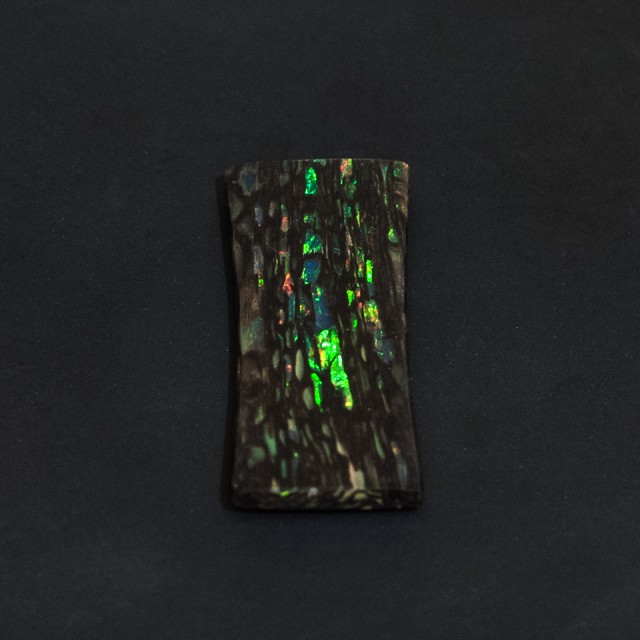
貴重なオパールの種類
ご想像のとおり、このリストにあるすべてのオパールには遊色効果があります。ただし、オパールの中には、コモンオパールとプレシャスオパールの2種類が存在する場合があります。
例えば、ウォーターオパールは遊色効果を示す場合と示さない場合があります。ブラックオパールには、一般的な形状と貴重な形状があります。
そうは言っても、多くのオパールの種類は常に遊色効果を示し、独自のユニークな特徴をもたらします。
ボルダーオパール
すべてのプレシャスオパールが虹のすべての色を放つわけではないことを覚えていますか?しかし、ボルダーオパールは例外です。ボルダーオパールの遊色効果は、虹の7色すべてを放ちます!
ボルダーオパールはオーストラリアのクイーンズランド州産です。この品種は、鉄鉱石とマトリックス状または層状の模様を形成することがよくあります。

貴重なブラックオパール
その名の通り、貴重なブラックオパールは黒色をしています。オパールのような輝きはほとんどないものの、驚くほど美しい色彩を放ちます。
貴重なブラックオパールの黒いベースが、遊色効果をさらに鮮やかに輝かせます。この希少なオパールの主な産地は、オーストラリアのライトニングリッジです。
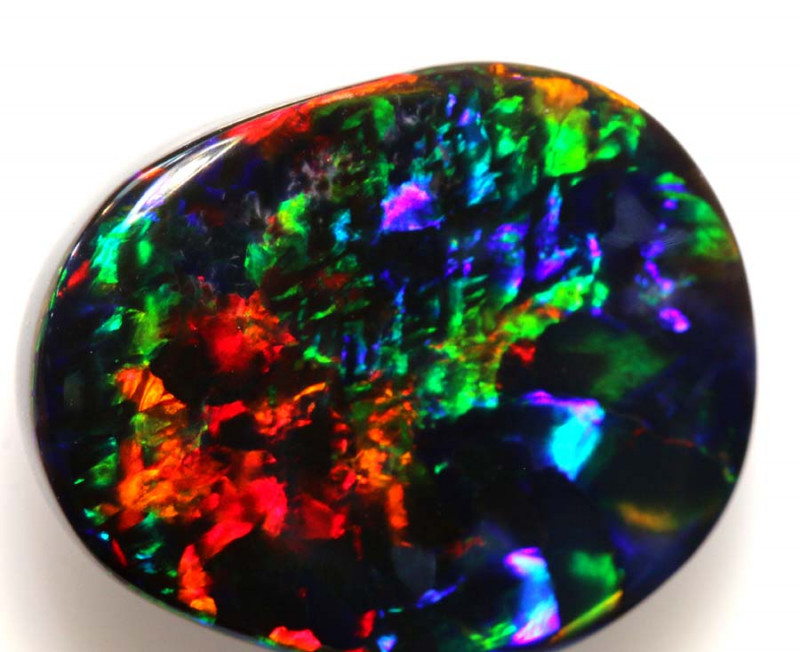
クリスタルオパール
クリスタルオパールの名前は、その半透明性に由来しています。この種類は光をある程度透過するためです。実際、クリスタルオパールの半透明性は、石の表面と内部に遊色効果を生み出します。
光を当てるとゼリーのような模様になり、「ゼリーオパール」と呼ばれることもあります。ベーストーンは多彩で、青、黄、白、さらには黒の結晶色まであります。

マトリックスオパール
マトリックスオパールは、「タイプ3オパール」とも呼ばれ、独特の遊色効果を持つオパールのグループを指します。石の表面全体に遊色効果が現れる他のオパールとは異なり、マトリックスオパールの遊色効果は石全体にわたって現れます。
マトリックスオパールは世界中で採掘されており、母岩と結合した状態で発見されます。一般的な母岩には、鉄岩、石灰岩、砂岩、流紋岩、玄武岩などがあります。
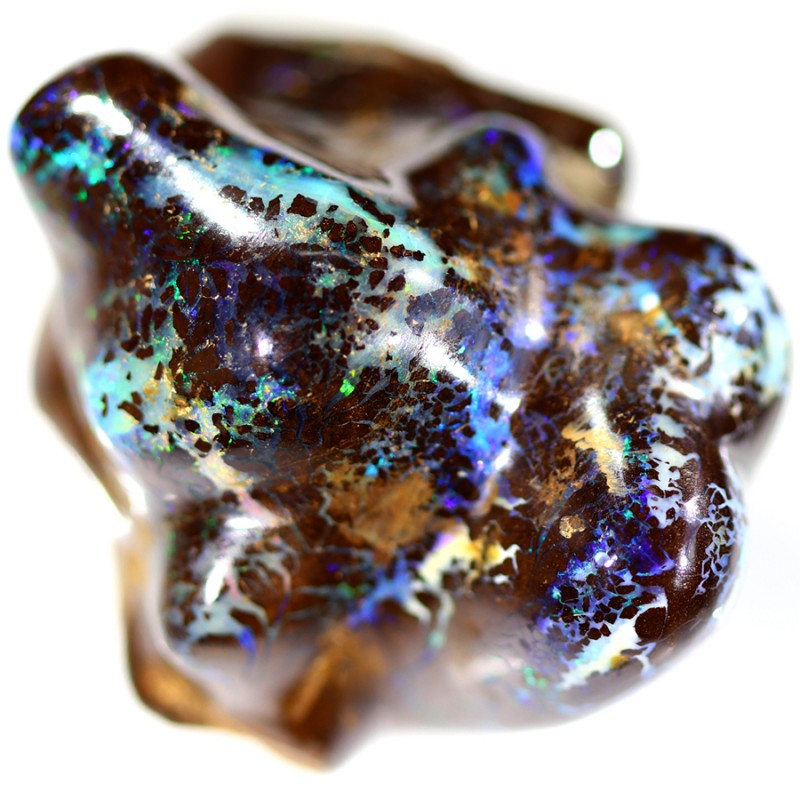
模様のある貴重なオパール
遊色効果は、オパールの独特な模様に現れることがあります。いくつかの模様は特定の名前で呼ばれ、そのオパールの品種の愛称となっています。
最も注目すべきパターンは次のとおりです。
ピンファイア。ピンファイア、またはピンポイントは、オパール全体に小さな集中した領域に現れる遊色模様を指します。この模様は、まるで色を散りばめたかのようです。

フレイムオパールの遊色効果は、石の表面を燃え盛る炎のような赤い縞模様が爆発的に広がる様子です。石を手で回すと、炎が入り込み、ろうそくの灯りのようにきらめき、遊色効果が輝きます。

ハーレクイン。最も人気のある種類であるハーレクイン模様のオパールは、長方形とダイヤモンド型の繰り返し模様が特徴です。モザイク模様は多様で、12種類以上のデザインにそれぞれニックネームが付けられています。

美しいオパールは実に豊富に揃っています。では、最も価値の高いオパールはどんな種類でしょうか?
最高品質のオパールとは何ですか?
最高のオパールを選ぶのは難しいものです。ダイヤモンドなどの他の宝石には、一貫性があり分かりやすい品質評価システムがあります。しかし、オパールの等級付けはそれほど単純ではありません。
オパールを評価するには、さまざまな変数を考慮する必要がありますが、その一部にはオパール専門家だけが自信を持って提供できる主観的な意見が必要です。
貴重なオパールと一般的なオパールの違いを考慮すると、ミックスに別の層が加わります。
まず、コモンオパールの品質を見てみましょう。「コモン」という言葉を聞くと、「コモンオパールは価値があるのか?」と疑問に思うかもしれません。
端的に言えば、状況によります。コモンオパールはプレシャスオパールよりも世界的に豊富です。しかし、一部の「コモン」オパールは他の種類よりも希少であり、より価値が高くなります。
コモンオパールとプレシャスオパールの両方において、最も価値の高い色は赤または黒です。プレシャスオパールの多くの遊色模様の中でも、ハーレクインが最も高く評価されています。
オパールはどれも、色が明るいほど価値が高くなります。無処理、無内包物、そして信頼できる産地から産出されたオパールは、常に高品質です。

お気に入りのオパールを誇示しましょう!
貴重なオパールと一般的なオパールの違いがわかったので、知識を共有し、お気に入りの種類を披露する準備が整いました。
珍しいコモンオパールの品種にご興味をお持ちですか?あのゴージャスなプレシャスオパールの模様が気になって仕方ありませんか? よく分かります!
当店では、オパールリングやブレスレットからタンブルブラックオパールやクリスタルオパールまで、さまざまな種類のオパールを取り揃えております。
決められない?今すぐ当社のオパールコレクションをご覧ください!
Opal Encyclopedia検索
最新記事
ブラックオパールは、オパールの中でも最も人気のある種類です。深いベースが表面に虹色の輝きを放ちます。ブラックオパールの用途、特性、歴史、そして価値についてご紹介します。
7th Dec 2025
オパールの等級付け方法と価格に影響を与える要因をご紹介します。色や輝き、カットや産地など、それぞれのオパールの価値がどのように評価されるのか、価格帯の例とともにご紹介します。
19th Jul 2023
記事のカテゴリ
All there is to know about Opals including Black Opals, Ethiopian Opals & Boulder Opal
14記事数
Check out our fascinating information and articles on all things amazing in the Opal world
41記事数




